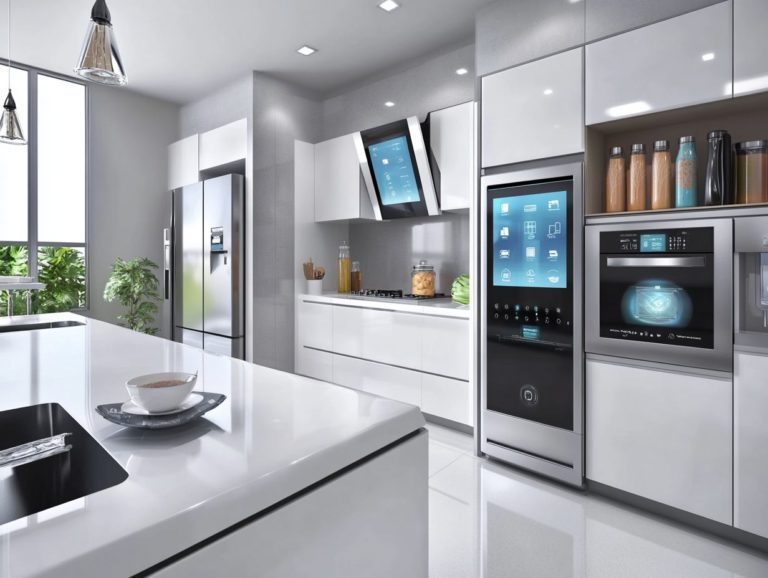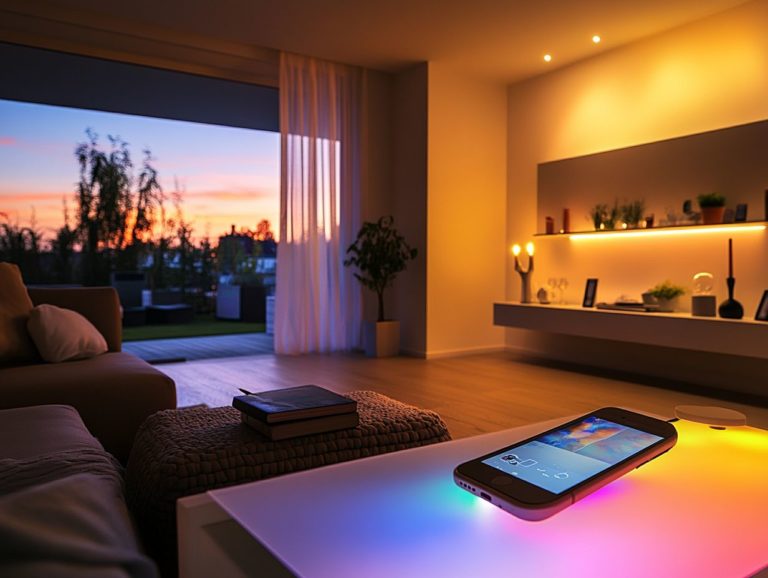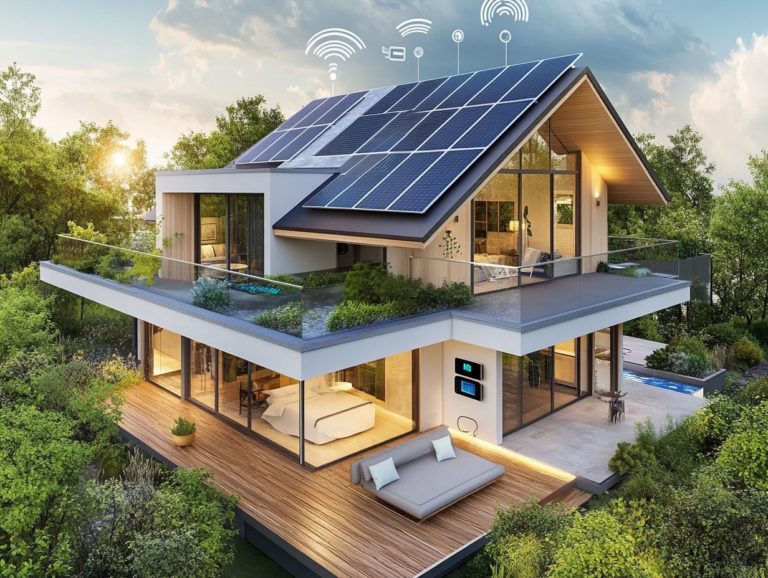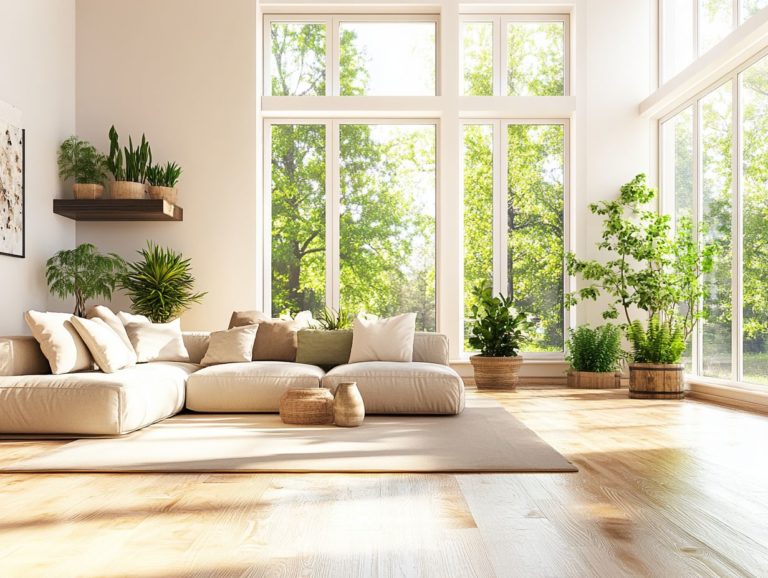How to Optimize Energy Use with Smart Home Tech
Smart home technology has transformed how you manage your living spaces, providing innovative solutions to optimize energy use.
This article delves into the myriad benefits of adopting smart devices ranging from reducing your environmental footprint to enjoying significant cost savings.
Discover the various types of smart home technologies at your disposal, such as smart thermostats and appliances, and learn the best ways to implement them in your home.
With practical tips for getting the most savings on energy, you have the opportunity to create a more efficient and sustainable living environment.
Contents
Key Takeaways:
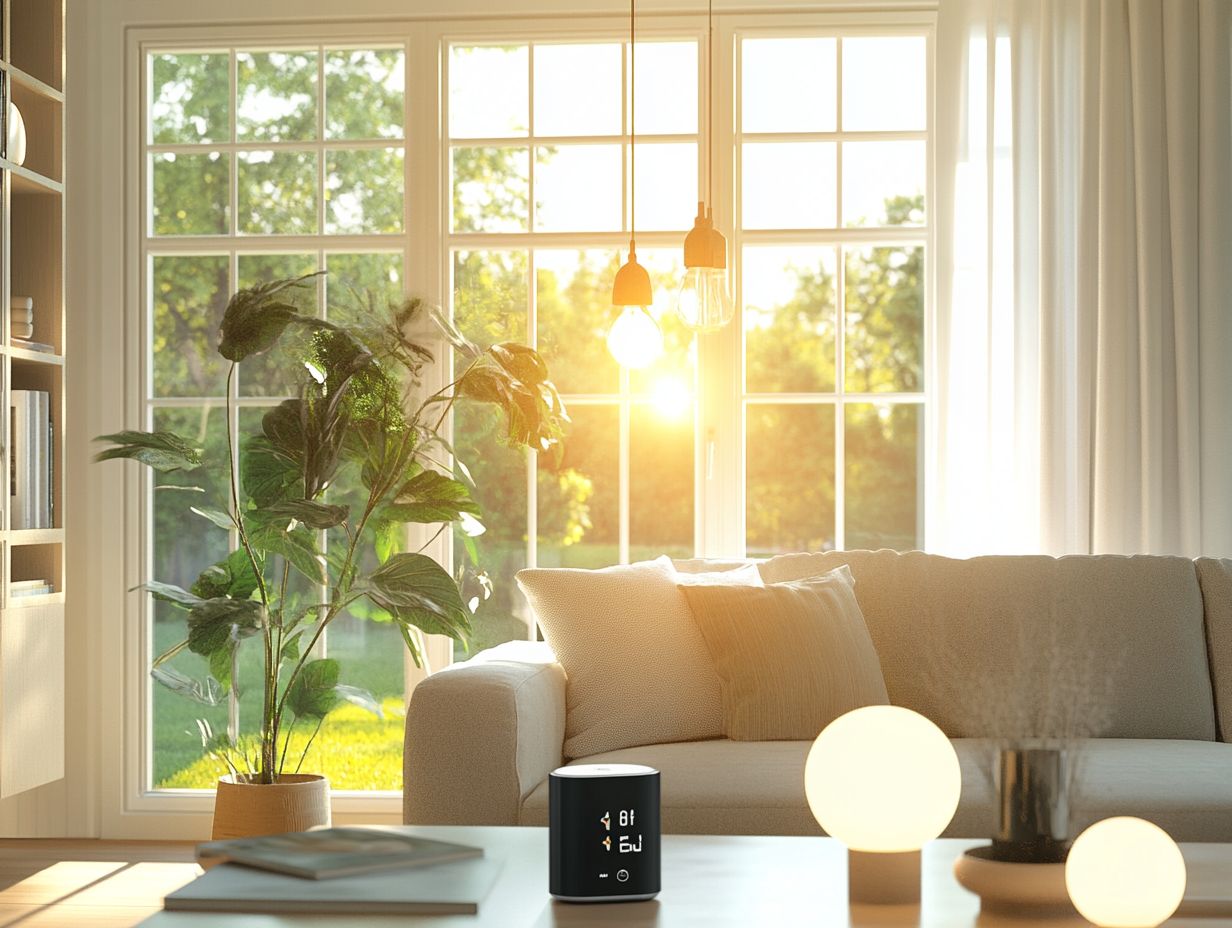
- Smart home technology optimizes energy use, benefiting the environment and your wallet.
- Key devices include smart thermostats, lighting, and appliances.
- For maximum energy savings, ensure proper installation, use custom schedules, and monitor regularly.
What is Smart Home Technology?
Smart home technology includes devices that work together to make your home smarter. This means you can control things like temperature and lights from your phone or with your voice.
By using wireless connections and automated control, you create a seamless smart home ecosystem that optimizes energy consumption and enhances your quality of life. For more insights, check out this guide on how to upgrade your home for energy efficiency.
Imagine smart security systems providing real-time surveillance and alerts, along with smart speakers responding to your voice. Each component of this technology works together effortlessly. You can adjust lighting and temperature settings using mobile apps or voice assistants, ensuring comfort while promoting energy savings.
Specific smart devices like smart plugs and intelligent irrigation systems play a crucial role. They monitor usage patterns and make automatic adjustments, effectively cutting down on waste and boosting overall functionality.
Embracing smart home technology is not just about convenience; it enhances your lifestyle with intelligent solutions.
Benefits of Optimizing Energy Use
Optimizing energy use with smart technology brings fantastic benefits. You save money while helping the environment. It enhances energy efficiency and fosters sustainable living through green practices and advanced energy management.
When you invest in smart energy solutions, you can dramatically lower your heating and cooling costs while enjoying tailored climate control options.
Environmental Impact
The environmental impact is impressive. By using clean energy sources, you can lower your carbon footprint and help create a sustainable future.
Implementing energy management systems and choosing energy-efficient appliances means you’re making a choice for your home and actively participating in lowering greenhouse gas emissions.
These advanced systems provide real-time monitoring of energy use and let you make proactive adjustments, drastically reducing usage during peak hours. By integrating renewable energy sources like solar panels into your smart home grid, you elevate your sustainability efforts.
This blend of technology and eco-consciousness encourages responsible energy usage and helps you make informed choices.
Smart home technology serves as a catalyst for collective environmental action, paving the way for reduced reliance on fossil fuels. Incorporating 5 tips for energy-efficient home renovation can further usher in a cleaner, greener future.
Cost Savings
Implementing smart home technology can lead to remarkable cost savings on your energy bills. Smart energy management systems optimize consumption and eliminate unnecessary expenses. You can leverage smart devices, like smart thermostats and energy-efficient appliances, to monitor and control your home s energy usage, maximizing your savings.
For example, a smart thermostat learns your scheduling habits. It automatically adjusts the heating and cooling settings, ensuring energy isn t wasted when no one is home. Smart lighting systems let you schedule lights to turn off when rooms are unoccupied or dim automatically based on natural light levels, further reducing your electricity costs.
Integrating smart plugs enables you to monitor energy consumption for specific devices. This provides valuable insights into where energy might be leaking. Energy-efficient appliances, such as smart refrigerators and washers, significantly lower electricity usage compared to traditional models, allowing you to enjoy modern convenience while keeping costs in check.
Types of Smart Home Technology for Energy Optimization
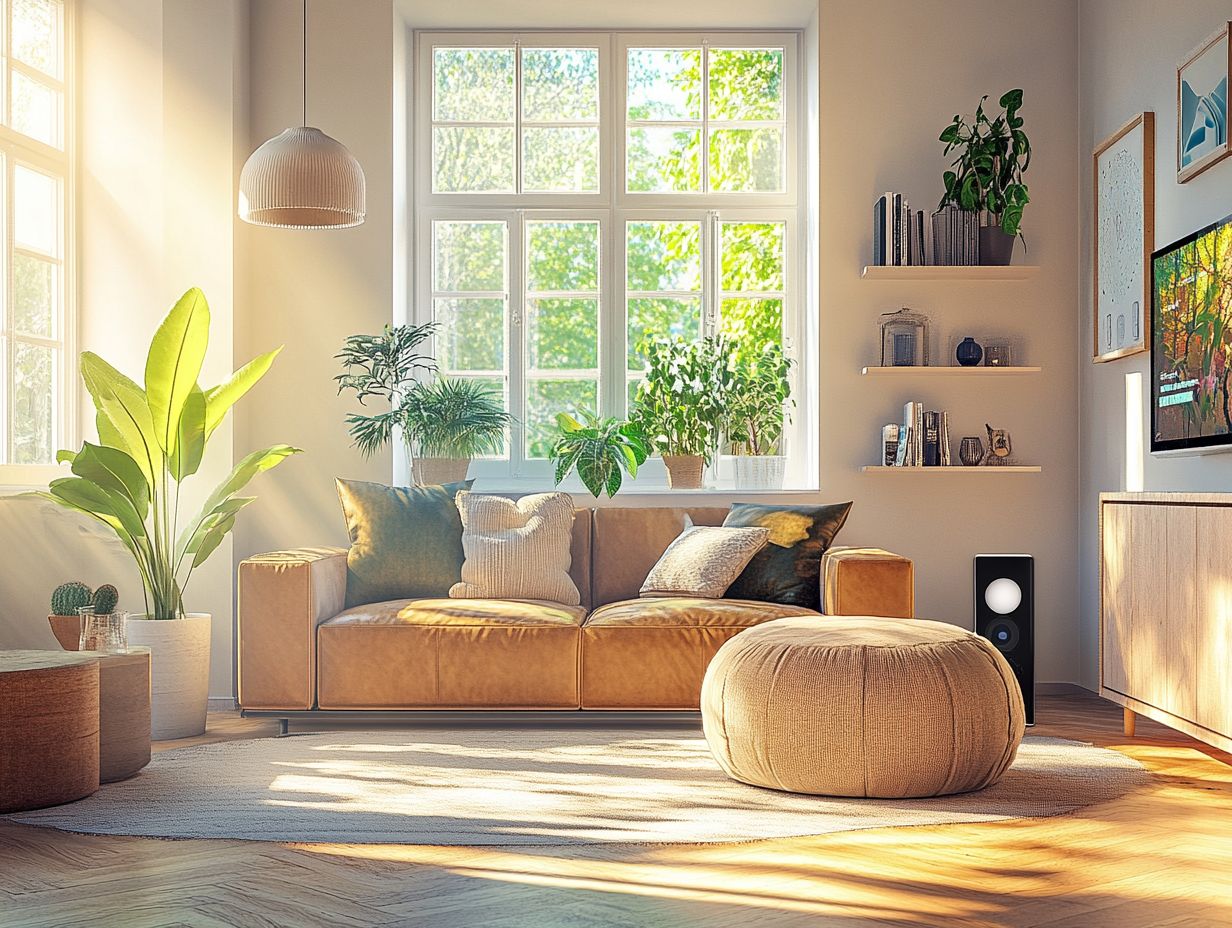
You ll find an array of smart home technologies designed for energy optimization.
Imagine smart thermostats that seamlessly manage your heating and cooling. They ensure comfort while maximizing efficiency. Picture smart lighting systems that adjust automatically based on occupancy, illuminating your space only when it s needed.
Energy-efficient appliances minimize consumption without compromising performance. Smart plugs and various smart devices let you control your energy usage remotely, taking your energy management to new heights.
Smart Thermostats
Smart thermostats are sophisticated devices for controlling your heating and cooling systems efficiently. With features like automated schedules, remote control via mobile apps, and energy usage monitoring, you can achieve significant energy savings.
By using occupancy detection and smart energy practices, these thermostats adapt to your lifestyle, optimizing energy management and reducing costs.
These smart devices learn your habits over time, allowing for customized temperature adjustments that keep you comfortable while saving energy. Many smart thermostats easily integrate with other smart home technologies, creating a cohesive system that connects everything from smart lights to security cameras.
Monitoring energy usage patterns highlights the role of these thermostats in promoting sustainable practices that benefit both the environment and your household budget. Whether you choose programmable models or those with advanced connectivity options, you can enjoy the peace of mind that comes with efficient energy management.
Smart Lighting
Smart lighting solutions use cutting-edge technology to enhance your home experience, offering unparalleled convenience and energy efficiency. Take control of your lighting from anywhere! You can establish automated schedules that sync perfectly with your daily routine.
With features like occupancy detection and energy monitoring, these smart systems reduce electricity consumption while delivering optimal illumination.
This modern approach aligns with the growing demand for energy-efficient appliances that champion sustainability. You can customize your lighting environment through intuitive apps ensuring lights turn off automatically when a room is vacant or adjust their brightness in harmony with natural daylight.
Integrating these systems with other smart home devices expands the possibilities for a seamless, automated lifestyle, giving you exceptional control. By embracing these innovative solutions, you can enjoy both comfort and savings, paving the way for a more responsible and efficient lighting experience in your home.
Smart Appliances
Smart appliances are expertly crafted to optimize energy consumption while offering advanced features that elevate your daily living experience. With capabilities like remote control and energy usage analytics, devices such as smart refrigerators and washing machines not only enhance convenience but also promote energy savings through their energy-efficient designs and functionalities.
Moreover, smart thermostats play an essential role in regulating your home’s temperature by learning your preferences and automatically adjusting settings, which can significantly reduce your heating and cooling costs. To further enhance your home’s efficiency, consider exploring 5 ways to improve your home’s efficiency today. Imagine having smart lighting systems that allow you to control brightness and schedules remotely or through sensors, ensuring that lights are only on when you actually need them.
Energy monitoring plugs and outlets provide valuable insights into the energy consumption patterns of your devices, enabling you to make informed decisions about how you use energy. Together, these innovations transform your home into an energy-efficient haven, ultimately leading to lower utility bills and a reduced carbon footprint.
How to Implement Smart Home Technology
Implementing smart home technology requires a meticulous installation and setup process, ensuring that your devices are compatible and seamlessly integrated into a unified smart home system.
Establish a compatibility plan to ensure smooth communication among your devices. This will aid in efficient energy management and optimal performance of all your smart technology.
Installation and Set-Up
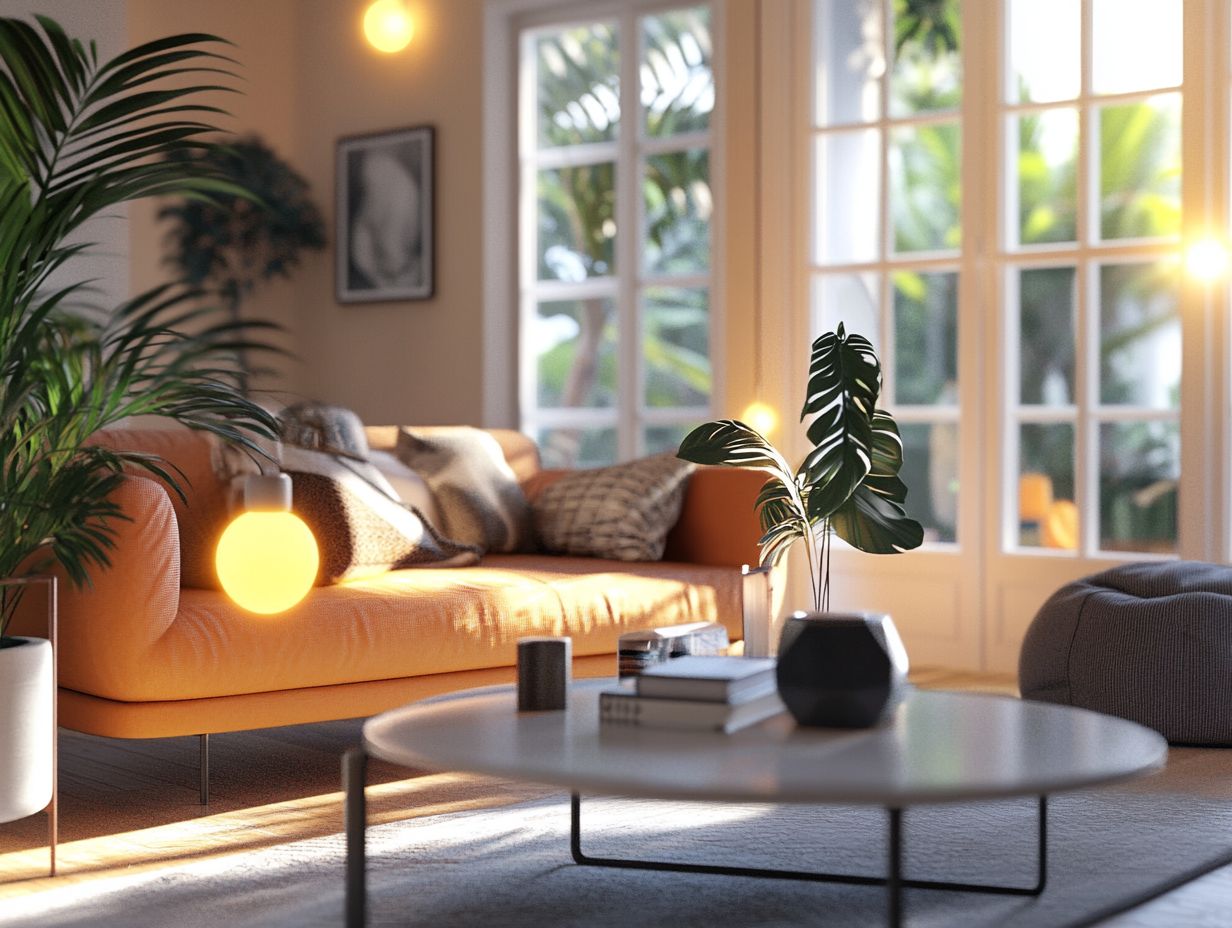
Installing and setting up smart home systems requires careful planning. Ensure each smart device is positioned and connected for the best performance. Establishing a compatibility plan can streamline the integration process, enabling your energy management systems to work seamlessly across various devices.
Begin by assessing your existing infrastructure, such as the strength of your Wi-Fi and the layout of your electrical systems, as these factors play a crucial role in the effectiveness of your smart home ecosystem. Choose devices that communicate effectively using established protocols like Zigbee (a wireless communication standard) or Z-Wave (a technology for home automation). This choice will greatly enhance functionality and energy efficiency.
In terms of placement, be strategic with your devices, think sensors and smart thermostats: saving energy the smart way to ensure accurate usage monitoring and optimization. By taking these thoughtful steps, you can create a cohesive system that simplifies your daily routines and boosts energy savings.
Integration with Other Devices
Integrating smart home technology with other devices is essential for crafting a comprehensive and efficient smart home ecosystem, allowing you to elevate energy management and automation to new heights. A thoughtfully designed compatibility plan ensures that devices from various manufacturers, such as Samsung SmartThings, Google Nest, and Amazon Echo Dot, function in perfect harmony.
By guaranteeing that your sensors, lights, and thermostats communicate seamlessly, you can optimize energy consumption and trim down those utility bills. For example, imagine your smart thermostat detecting that no one is home and automatically sending a command to adjust the lighting and appliances; now that’s energy efficiency in action. To further enhance your efforts, consider these 5 ways to reduce energy waste at home.
Embracing strategies like utilizing open-source platforms or smart hubs can significantly boost interoperability among your devices. By prioritizing products that support common protocols, like Zigbee or Z-Wave, you can sidestep compatibility issues and establish a unified control system, effortlessly managing your smart environment with ease and sophistication.
Tips for Maximizing Energy Savings
Maximizing energy savings in your smart home involves embracing smart energy practices that truly elevate your experience. Imagine creating customized schedules for your devices, actively monitoring your energy usage, and utilizing a sophisticated smart energy dashboard to track performance and optimize consumption.
Start implementing these strategies now! Make informed decisions that enhance your energy efficiency and cut costs immediately. For detailed guidance, check out how to create an energy-efficient home office. It’s about taking control and ensuring your home operates at its best while saving you money.
Creating Customized Schedules
Creating customized schedules for your smart devices is a savvy strategy to optimize energy consumption. You can easily program your devices to operate only when needed. This helps manage energy usage more efficiently and contributes to your overall energy management and savings.
By using these smart scheduling features, you stand to significantly reduce your electricity bills while also minimizing your carbon footprint. For example, top energy-saving tips for homeowners suggest utilizing smart thermostat devices that automatically adjust the heating and cooling in your home, which can be programmed to change temperatures according to your daily routines. This ensures energy isn’t wasted when your home is empty.
Smart lighting systems can also turn off automatically during the day or dim when natural light is ample. This level of automation enhances your comfort and fosters a sustainable living environment, making it easier for you to align your household energy consumption with eco-friendly practices. Additionally, you can explore how to make your home more energy efficient for further improvements.
Monitoring and Adjusting Usage
Monitoring your energy usage through smart home technology enables you to identify patterns and make adjustments that effectively optimize your energy consumption. By utilizing a smart energy dashboard, you gain valuable insights into your energy performance. This helps you pinpoint opportunities for improvement and enhances your energy optimization efforts.
With this data at your fingertips, you can fine-tune your usage habits. Adjust your heating, cooling, and lighting systems based on real-time feedback. This proactive approach minimizes waste and leads to significant cost savings over time. To further enhance your efforts, consider maximizing energy efficiency through smart home features like programmable thermostats and energy-efficient appliances that seamlessly integrate into your daily routine, allowing for effortless management of energy use.
By embracing automation and remote monitoring capabilities, you can ensure that your energy footprint is minimized all while enjoying the comforts of modern living.
Frequently Asked Questions

What is smart home technology and how can it help optimize energy use?
Smart home technology refers to devices and systems that are connected to the internet and can be controlled remotely. These devices can help optimize energy use by allowing users to monitor and control their energy consumption in real-time.
How can I use smart home technology to save energy and reduce my utility bills?
Smart home technology offers several ways to save energy and reduce utility bills. For example, you can use smart thermostats to regulate your home’s temperature, smart lighting to control the amount of light used, and smart appliances to minimize energy usage.
Do I need to have a complete smart home system to optimize energy use?
No, you do not need a complete smart home system to optimize energy use. You can start with a few simple devices, such as smart thermostats and smart plugs, and gradually expand as needed.
Can smart home technology adapt to my energy usage patterns?
Yes! Smart home technology can learn your habits and optimize energy use just for you. This can help save you money in the long run.
Are there any other benefits of using smart home technology for energy optimization?
Aside from saving energy and reducing utility bills, using smart home technology can also improve the overall comfort and convenience of your home. You can remotely control devices, receive real-time energy usage data, and set schedules for more efficient energy usage.
Is it difficult to set up and use smart home technology for energy optimization?
No, setting up and using smart home technology for energy optimization is relatively easy. Most devices come with user-friendly interfaces and can be easily integrated into existing home systems. You can also seek professional installation assistance if needed.
Take the first step towards energy savings and comfort explore smart home devices now!


